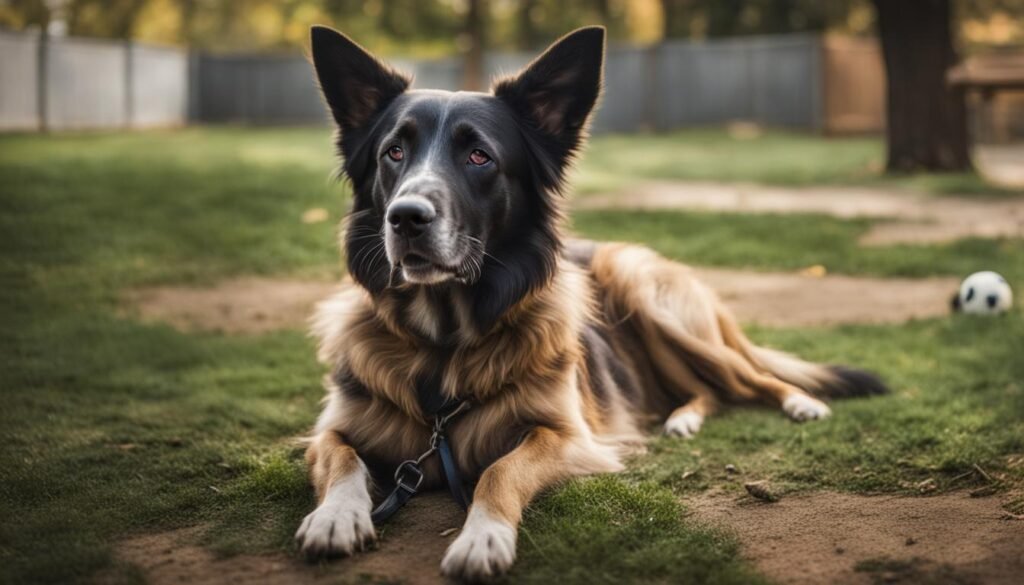Can hearing loss in dogs cause anxiety? This is an important consideration, particularly for ageing canines. As dogs reach their senior years, hearing loss can lead to notable behavioural changes and heightened anxiety levels. Though dogs are often more adaptable to hearing loss than humans, the condition can still result in confusion and disorientation.
Signs of hearing loss in dogs may include not responding to familiar sounds, having trouble waking up, excessive barking, and reduced alertness. This altered perception of their environment can be disconcerting and contribute to anxiety. Senior dogs undergoing hearing loss may need a period of adjustment. During this transition, providing them with support and reassurance is key to helping them cope and potentially reducing anxiety levels.

Key Takeaways:
- Hearing loss in dogs, especially in their senior years, can lead to anxiety and behavioural changes.
- Signs of hearing loss in dogs include not responding to sounds they are used to, difficulty waking up, excessive barking, and a lack of usual alertness.
- Dogs may experience anxiety due to the disconnect between their perception of the environment and expectations.
- Support and reassurance can help alleviate anxiety in dogs with hearing loss.
- Senior dogs may undergo a period of transition as they adapt to hearing loss, requiring additional support during this time.
The Impact of Hearing Loss on Dogs
Hearing loss in dogs can significantly impact their overall well-being, particularly when it comes to their mental and emotional state. Dogs with hearing loss may experience heightened levels of anxiety, which can manifest in various behavioural changes. Pet owners must understand how hearing loss can lead to anxiety in dogs and take appropriate steps to manage and support their furry friends.
Dogs rely heavily on their senses, including hearing, to navigate the world around them. When they lose this sense, they may become disoriented and confused, leading to increased anxiety. The world becomes a different place for them, with sounds they used to rely on for guidance and cues no longer present. This disconnect can be stressful and overwhelming for dogs, causing them to exhibit signs of anxiety in their behaviour.
Explore the latest insights on whether migraines can cause hearing loss.
Managing anxiety in dogs with hearing loss involves providing support, reassurance, and alternative communication methods. Creating a calm and structured environment can help dogs feel more secure. Visual cues such as hand gestures or sign language can aid in communication, helping dogs understand and respond to commands. Additionally, seeking guidance from experienced trainers or behaviourists can provide valuable insight into retraining techniques and reducing anxiety in dogs with hearing loss.
Signs of Anxiety in Dogs with Hearing Loss
- Increased restlessness and pacing
- Excessive barking or whining
- Difficulty settling down
- Startling easily
- Increased aggression or irritability
- Loss of appetite
- Changes in elimination habits
- Seeking constant reassurance
Closely observing a dog’s behaviour and recognizing the signs of anxiety is essential for early intervention. By understanding the impact of hearing loss on dogs and actively addressing their anxiety, pet owners can help their furry companions lead happier and healthier lives.
Signs of Hearing Loss in Dogs
Hearing loss in dogs can be subtle, and pet owners may not immediately recognize the signs. However, being observant and proactive can help identify the early indicators of hearing loss in dogs. Some common signs to watch for include:
- Dogs not responding to their name
- Lack of response to sounds they used to react to
- Difficulty waking up
- Startling easily when touched
- Excessive barking
- Lack of usual alertness
In addition to these signs, dogs with hearing loss may exhibit confusion or disorientation in familiar surroundings. If you notice any of these behaviours in your dog, it’s important to consult with a veterinarian for a proper diagnosis.
Why is it important to address signs of hearing loss?
Hearing loss can impact a dog’s overall quality of life and lead to increased anxiety and behavioral changes. By addressing signs of hearing loss early on, pet owners can provide the necessary support and adapt their communication methods to ensure their dog’s well-being.
Understanding the signs of hearing loss in dogs is crucial for pet owners to provide appropriate care and support to their furry companions. By recognizing these signs, pet owners can proactively address their dog’s needs and help them adapt to their new reality.
Coping with Canine Hearing Loss
Dealing with hearing loss can be challenging for dogs, but several strategies can help them cope and maintain a good quality of life. One effective method is using vibration collars, which provide cues and teach deaf dogs to look at their owners for communication. These collars can be customized to vibrate in response to specific commands or signals, allowing for clear and consistent communication. Sign language can also be effective for deaf dogs, as they often respond well to visual cues. Clear and consistent hand signals can be taught to convey basic commands and messages.
Additionally, additional tools and techniques can aid the adaptation process for dogs with hearing loss. For example, practising with flashing lights or vibration cues can help reinforce commands and signals. This visual reinforcement can assist dogs in understanding and responding appropriately, reducing their anxiety and confusion. Working with experienced trainers or behaviourists who can guide retraining techniques and reduce anxiety in dogs with hearing loss is essential.
Communication with Deaf Dogs
Communication with a deaf dog requires some adjustments and alternative methods. Establishing consistent language between the owner and the dog is crucial. Simple gestures, such as a thumbs up for “good job” or an open palm for “stop,” can effectively convey messages. Patience and consistency are key when working with a deaf dog, as they rely heavily on visual cues to understand their surroundings. It may take time for both the dog and the owner to become comfortable with the new communication methods, but a strong bond can be developed with practice and positive reinforcement.
Read also: Can a tooth infection cause hearing loss?
Remember, it’s important to be aware of your body language when communicating with a deaf dog. Dogs are susceptible to non-verbal cues, so maintaining an open and relaxed posture can help alleviate any potential anxiety or confusion. By adapting to their specific needs and providing clear communication, owners can support their deaf dogs and create a harmonious environment for them to thrive.

“Communication is not limited to sound. It’s about understanding and connecting with your deaf dog on a deeper level. Through consistent visual signals and clear gestures, you can bridge the gap and create a strong bond of communication without words.” – Anonymous
Safety Precautions for Deaf Dogs
When caring for a deaf dog, taking certain safety precautions is important to ensure their well-being. Deaf dogs rely heavily on their other senses, so adjusting their environment and communication methods is crucial. Here are some safety precautions to consider:
- Keep your deaf dog leashed: A deaf dog may be unable to hear potential dangers, such as approaching cars or other animals. Keeping them leashed while outside can prevent accidents and keep them safe.
- Use visual aids: Adding bells or lights to your deaf dog’s collar can help you locate them visually, especially in low-light situations. This can be particularly helpful if your dog happens to wander away.
- Maintain a secure environment: Ensure your home and yard are secure to prevent your deaf dog from escaping. Fences should be in good condition, and gates should be securely latched to keep them safely contained.
- Provide clear visual cues: Use hand signals or sign language to communicate with your deaf dog. Consistent and clear visual cues can help them understand commands and navigate their surroundings more effectively.
- Microchip your deaf dog: Having them microchipped is essential and ensuring their information is current. If they get lost, a microchip can help identify them and increase the chances of a safe return.
By implementing these safety precautions, you can help create a secure and supportive environment for your deaf dog. Remember, patience and understanding are key when caring for a dog with hearing loss.
Dealing with Different Types of Hearing Loss in Dogs
Understanding the types of hearing loss in dogs is essential for effectively managing and supporting their needs. Hearing loss can be either congenital or acquired, each with its own unique characteristics and causes.
Congenital hearing loss: This type of hearing loss is present at birth or occurs shortly after. It is often associated with factors such as coat colour or pigment-related issues. Certain breeds, like Dalmatians and Australian Shepherds, may be more prone to congenital hearing loss. Identifying congenital hearing loss early on is crucial for implementing appropriate strategies and support.
Acquired hearing loss occurs later in a dog’s life and can have various causes. It may result from ear infections, ear trauma, exposure to loud noises, drug complications, or age-related degeneration of the hearing apparatus. Identifying the cause of acquired hearing loss can help tailor management approaches and interventions.
By understanding whether a dog’s hearing loss is congenital or acquired, pet owners can work closely with veterinarians and trainers to develop personalized strategies that address the unique needs and challenges associated with each type of hearing loss.

Common Signs of Congenital and Acquired Hearing Loss:
- Failure to respond to sounds or their name
- Lack of reaction to familiar noises that are used to elicit a response
- Difficulty waking up, appearing more lethargic
- Startling easily when touched or approached suddenly
- Excessive barking or vocalization
- Seeming disoriented or confused in familiar environments
- Decreased alertness or responsiveness
Recognizing these signs early on can help pet owners seek appropriate veterinary care and implement strategies to support their dogs with hearing loss.
Caring for a Deaf Dog
Caring for a deaf dog requires some adjustments and alternative methods of communication. When it comes to interacting with your furry friend, visual signals are key. Incorporate hand gestures or sign language to communicate commands and cues effectively. This not only helps your deaf dog understand what you want from them but also strengthens the bond between you.
In addition to visual communication, tools such as vibration collars can assist in training and communication. These collars provide gentle vibrations that serve as cues, helping your deaf dog understand and respond to instructions. These tools can be particularly beneficial when teaching new commands or cues.
Regular visits to a trusted veterinarian are crucial for monitoring and managing your dog’s hearing loss. Your vet can provide valuable recommendations and resources to help you and your furry companion navigate the challenges of hearing loss. They can also assist in adapting to your dog’s new lifestyle, ensuring their overall well-being and quality of life.
Conclusion
Hearing loss in dogs can have a significant impact on their well-being, causing anxiety and behavioural changes. Pet owners must be vigilant and recognize the signs of hearing loss in their furry companions. By providing support and reassurance, we can confidently help them navigate their new reality.
Various tools and techniques are available to help deaf dogs adapt and communicate effectively. Visual signals, such as hand gestures or sign language, can bridge the communication gap and strengthen the bond between humans and their canine friends. Additionally, vibration collars and other training methods can assist in training and cueing deaf dogs.
Dive into the details on how to know if hearing loss is permanent
Safety precautions are essential in ensuring the welfare of deaf dogs. Keeping them leashed and adding bells or lights to their collars can help owners locate them visually and prevent accidents. Microchipping and proper training also play a vital role in ensuring their identification and return if they become lost.
By understanding the different types of hearing loss and seeking guidance from experienced trainers or behaviourists, we can provide the best care and support for our deaf dogs. With proper attention and management, deaf dogs can lead fulfilling lives full of love, companionship, and joy.
Frequently Asked Questions
Can hearing loss in dogs cause anxiety?
Yes, hearing loss in dogs, especially in their senior years, can lead to behavioural changes and anxiety.
What are the signs of hearing loss in dogs?
Signs of hearing loss in dogs include not responding to sounds they are used to, difficulty waking up, startling easily when touched, excessive barking, and lack of usual alertness.
How can I help my dog cope with hearing loss?
Tools and techniques such as vibration collars, sign language, and practising with flashing lights or vibration cues can help dogs adapt to their new reality. Working with experienced trainers or behaviourists can provide insight into retraining and reducing anxiety in dogs with hearing loss.
What safety precautions should I take for my deaf dog?
Deaf dogs should be kept leashed to ensure their safety, as they may not hear potential dangers like approaching cars or other animals. Leaving a trailing leash and adding bells or lights to the collar can help owners locate their deaf dog visually. Microchipping and proper training are also important.
What are the different types of hearing loss in dogs?
Hearing loss in dogs can be either congenital or acquired. Congenital hearing loss is usually linked to coat colour or pigment-related factors, while acquired hearing loss can be caused by factors such as ear infections, trauma to the ears, exposure to loud noises, drug complications, and age-related degeneration of the hearing apparatus.
How can I care for a deaf dog?
Caring for a deaf dog requires adjustments and alternative methods of communication, such as visual signals and training with vibration collars. Regular visits to a trusted veterinarian are important to monitor and manage a dog’s hearing loss and adapt to their new lifestyle.



